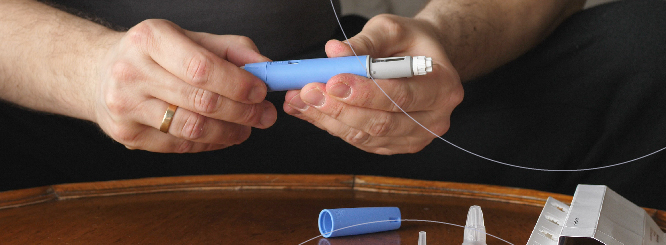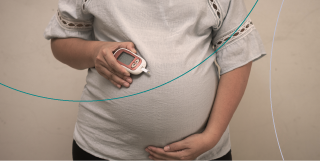
Diabetes is a chronic disease that affects the body, specifically the eyes, heart, kidneys, and nerves. This disease affects the processes of glucose, a type of sugar that serves as primary energy for the body. This condition is about how your body turns foods’ sugar into energy and around 422 million people worldwide have been diagnosed with diabetes[1]. When it comes to type 2 diabetes, this condition happens because of a problem in the way the body regulates and uses sugar as a fuel. This long-term condition results in too much sugar circulating in the blood and eventually, high blood sugar levels can lead to disorders of the circulatory, nervous and immune systems.
Patients from all different backgrounds arrive at LIMARP® because they’re looking to improve their quality of life and embark on a healthier path. Our multidisciplinary team, led by Dr. Liza María Pompa González, offers different health services to help you reach your weight goals and beat obesity: from diet and exercise plans, to psychological guidance and surgical intervention.
If you have type 2 diabetes and want to know if you’re a candidate for surgery, it’s important that you schedule an appointment at our Tijuana clinic so that you have all the necessary information you need, as well as the top-rated care and attention by our specialists.
In this article, we’ll talk more broadly about type 2 diabetes and the available surgeries a patient can undergo in order to treat it.
As always, we’d like to remind you that the information provided below is general and that all cases are different. If you recognize or are interested in any of the points mentioned, please schedule an appointment with a doctor so that they can determine the best treatment plan for you. Your health and safety is very important to us.
What is diabetes?
Also known as diabetes mellitus, this condition is known as a metabolic disorder that is characterized by high blood sugar (hyperglycemia) over a long period of time[2]. Diabetes presents itself when the pancreas is not producing enough insulin or when the body isn’t absorbing or properly responding to the amount of insulin that’s being produced. Insulin is the hormone responsible for helping glucose from food get into cells to be used for energy[3].
There are three different types of diabetes and each have different characteristics, as well as distinct causes:
- Type 1 diabetes: This type of diabetes results from failure of the pancreas to produce enough insulin due to loss of beta cells, which in turn is caused by an autoimmune response[4]. This type of diabetes is most common in children and young adults, but it can also develop during adulthood.
- Type 2 diabetes: The main cause for this type of diabetes is insulin resistance and although it’s more common in adults, the rise of obesity among children has also resulted in young people developing type 2 diabetes.
- Gestational diabetes: It occurs when pregnant women develop high blood sugar levels, and although their levels lower once they’ve given birth, they’re still at risk of developing type 2 diabetes in later years[5].
Some of the symptoms a person with diabetes may experience are increased thirst and appetite, as well as frequent urination. These symptoms can be considered mild, but if it goes untreated, diabetes can cause serious health problems, such as ketoacidosis, hyperosmolar hyperglycemic state, and complications like cardiovascular disease, stroke, chronic kidney disease, foot ulcers, damage to the nerves, damage to the eyes, and cognitive impairment.
Type 2 diabetes
Now that we’ve learned more about the different types of diabetes, let’s concentrate on type 2 diabetes, its causes, risk factors, symptoms, and available treatment. As we have briefly mentioned, type 2 diabetes is a condition that occurs when the body doesn’t use insulin correctly.
According to the CDC[6], “more than 37 million Americans have diabetes (about 1 in 10), and approximately 90-95% of them have type 2 diabetes. Type 2 diabetes most often develops in people over age 45, but more and more children, teens, and young adults are also developing it.”
In order to better understand how type 2 diabetes affects the body, it’s important to learn more about the causes, symptoms, and risk factors. Also, a simple blood test is enough to be diagnosed with this condition. Type 2 diabetes is caused by several factors, including lifestyle factors and genes. If the patient is overweight, obese, or doesn’t partake in any physical activity at all, they’re more likely to develop type 2 diabetes. Extra weight sometimes causes insulin resistance and is common in people with type 2 diabetes. The location of body fat also makes a difference since extra belly fat is linked to insulin resistance, type 2 diabetes, and heart and blood vessel disease.
Insulin resistance, as well as genes and family history, can also cause type 2 diabetes[7]. It usually begins with insulin resistance and the body needs more insulin to help glucose enter cells. At first, the pancreas makes more insulin to keep up with the added demand. Over time, the pancreas can’t make enough insulin, and blood glucose levels rise. Genes also can increase the risk of type 2 diabetes by increasing a person’s tendency to become overweight or have obesity.
Type 2 Diabetes and Surgery
According to the American Society for Metabolic and Bariatric Surgery (ASMBS), obesity and type 2 diabetes are closely related conditions, both linked to problems with the body’s metabolism. The same changes that lead to weight loss after surgery can also lead to the remission of type 2 diabetes. Most importantly, patients with this disease should know that the body’s ability to use sugar in a healthy way can be regained with surgery. Before considering surgery, treatment for type 2 diabetes consists of lifestyle changes to stabilize blood sugar levels and prevent further damage to the body through blood sugar control. People with this type of diabetes may also be prescribed medication, sometimes in high doses, to keep blood sugar levels under control.
When it comes to treating type 2 diabetes with surgery, metabolic or bariatric surgery is the best answer. According to one study, nearly all individuals who have surgery to treat diabetes show improvement in their diabetes, sometimes as quickly as a few days after surgery[8]. They experience lower blood sugar levels, need less diabetes medications, and see an improvement in diabetes-related health problems.
Overall, 78% of patients experience remission thus eliminating the need for diabetes medications.
Surgery for type 2 diabetes performed today is among the best studied therapies in modern medicine. Metabolic surgery results in less food intake and decreased calories absorbed and in changes to the metabolism that affect intestinal hormones that regulate blood sugar control. Bariatric surgery reduces hunger, increases the sense of fullness after meals, and assists the body’s ability to achieve a healthy weight.
Bariatric surgery has been proven to be the most effective therapy for diabetes but also greatly improves obesity and other associated conditions.
So, how do we know when a patient with type 2 diabetes is a candidate for metabolic surgery?
If the patient has a BMI of 30 or greater, they may qualify and will need to be in constant communication with their doctor to ensure a successful procedure and recovery. While there are risks when it comes to any type of surgery, it’s more dangerous to leave type 2 diabetes unattended, especially if the surgery has the potential to save the patient’s life.
Types of Surgery for Type 2 Diabetes
Next, we’ll list the best types of surgery to treat type 2 diabetes. Remember that you must speak with your bariatric surgeon to ensure which procedure is best for you.
Gastric Bypass:
This surgery alters the gastrointestinal tract allowing food to avoid most of the stomach and the upper portion of the small intestine. The operation results in significant weight loss, remission of type 2 diabetes in nearly 80% of patients, and improvement of diabetes in an additional 15%, allowing the patient to achieve and maintain a healthy weight.
Gastric Sleeve:
The sleeve is a procedure that removes a portion of the stomach. The remaining stomach is narrow and provides a much smaller pouch for food. The surgery also changes the metabolism and hormones produced by the intestines. Over 60% of patients will have remission of their type 2 diabetes after sleeve gastrectomy.
Duodenal Switch:
The duodenal switch is a malabsorptive surgery performed far less frequently than the gastric bypass, sleeve gastrectomy or the adjustable gastric band due to the complexity of the procedure and the greater risk of complications. Studies find, however, that the operation is most effective in inducing early and sustained remission or improvement of T2DM.
Contact Us to Learn More
If you or someone you know has type 2 diabetes and are considering surgery, schedule an appointment with one of our doctors. We can help determine the right treatment for you. Contact us online anytime or give us a call at (619) 373-0229.
References
- [1] “Diabetes”. https://www.who.int/health-topics/diabetes. (Accessed May 24, 2023).
- [2] “About diabetes”. https://web.archive.org/web/20140331094533/http://www.who.int/diabetes/action_online/basics/en/. (Accessed May 24, 2023).
- [3] “What is diabetes?”. https://www.niddk.nih.gov/health-information/diabetes/overview/what-is-diabetes. (Accessed May 24, 2023).
- [4] “Type 1 diabetes”. https://www.mayoclinic.org/diseases-conditions/type-1-diabetes/symptoms-causes/syc-20353011. (Accessed May 24, 2023).
- [5] “Gestational diabetes”. https://www.mayoclinic.org/diseases-conditions/gestational-diabetes/symptoms-causes/syc-20355339. (Accessed May 24, 2023).
- [6] “Type 2 Diabetes”. https://www.cdc.gov/diabetes/basics/type2.html. (Accessed May 24, 2023).
- [7] “Symptoms & Causes of Diabetes”. https://www.niddk.nih.gov/health-information/diabetes/overview/symptoms-causes#type. (Accessed May 24, 2023).
- [8] “Surgery for Diabetes”. https://asmbs.org/patients/surgery-for-diabetes. (Accessed May 24, 2023).


